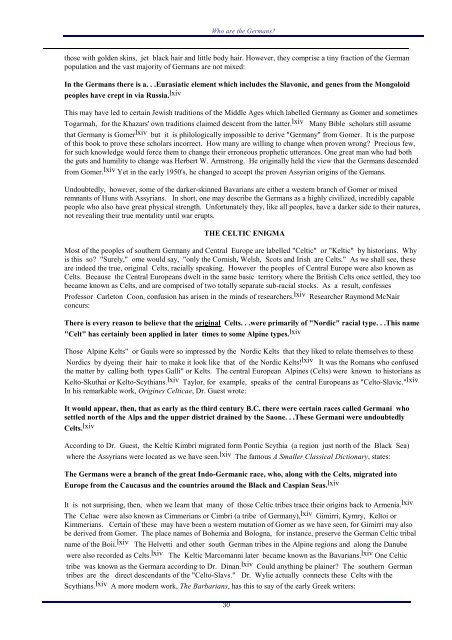WHO ARE THE GERMANS - Churches of God Cyber Auxiliary
WHO ARE THE GERMANS - Churches of God Cyber Auxiliary
WHO ARE THE GERMANS - Churches of God Cyber Auxiliary
You also want an ePaper? Increase the reach of your titles
YUMPU automatically turns print PDFs into web optimized ePapers that Google loves.
Who are the Germans?<br />
those with golden skins, jet black hair and little body hair. However, they comprise a tiny fraction <strong>of</strong> the German<br />
population and the vast majority <strong>of</strong> Germans are not mixed:<br />
In the Germans there is a. . .Eurasiatic element which includes the Slavonic, and genes from the Mongoloid<br />
peoples have crept in via Russia. lxiv<br />
This may have led to certain Jewish traditions <strong>of</strong> the Middle Ages which labelled Germany as Gomer and sometimes<br />
Togarmah, for the Khazars' own traditions claimed descent from the latter. lxiv Many Bible scholars still assume<br />
that Germany is Gomerlxiv but it is philologically impossible to derive "Germany" from Gomer. It is the purpose<br />
<strong>of</strong> this book to prove these scholars incorrect. How many are willing to change when proven wrong? Precious few,<br />
for such knowledge would force them to change their erroneous prophetic utterances. One great man who had both<br />
the guts and humility to change was Herbert W. Armstrong. He originally held the view that the Germans descended<br />
from Gomer. lxiv Yet in the early 1950's, he changed to accept the proven Assyrian origins <strong>of</strong> the Gemans.<br />
Undoubtedly, however, some <strong>of</strong> the darker-skinned Bavarians are either a western branch <strong>of</strong> Gomer or mixed<br />
remnants <strong>of</strong> Huns with Assyrians. In short, one may describe the Germans as a highly civilized, incredibly capable<br />
people who also have great physical strength. Unfortunately they, like all peoples, have a darker side to their natures,<br />
not revealing their true mentality until war erupts.<br />
<strong>THE</strong> CELTIC ENIGMA<br />
Most <strong>of</strong> the peoples <strong>of</strong> southern Germany and Central Europe are labelled "Celtic" or "Keltic" by historians. Why<br />
is this so? "Surely," ome would say, "only the Cornish, Welsh, Scots and Irish are Celts." As we shall see, these<br />
are indeed the true, original Celts, racially speaking. However the peoples <strong>of</strong> Central Europe were also known as<br />
Celts. Because the Central Europeans dwelt in the same basic territory where the British Celts once settled, they too<br />
became known as Celts, and are comprised <strong>of</strong> two totally separate sub-racial stocks. As a result, confesses<br />
Pr<strong>of</strong>essor Carleton Coon, confusion has arisen in the minds <strong>of</strong> researchers. lxiv Researcher Raymond McNair<br />
concurs:<br />
There is every reason to believe that the original Celts. . .were primarily <strong>of</strong> "Nordic" racial type. . .This name<br />
"Celt" has certainly been applied in later times to some Alpine types. lxiv<br />
Those Alpine Kelts" or Gauls were so impressed by the Nordic Kelts that they liked to relate themselves to these<br />
Nordics by dyeing their hair to make it look like that <strong>of</strong> the Nordic Kelts! lxiv It was the Romans who confused<br />
the matter by calling both types Galli" or Kelts. The central European Alpines (Celts) were known to historians as<br />
Kelto-Skuthai or Kelto-Scythians. lxiv Taylor, for example, speaks <strong>of</strong> the central Europeans as "Celto-Slavic." lxiv<br />
In his remarkable work, Origines Celticae, Dr. Guest wrote:<br />
It would appear, then, that as early as the third century B.C. there were certain races called Germani who<br />
settled north <strong>of</strong> the Alps and the upper district drained by the Saone. . .These Germani were undoubtedly<br />
Celts. lxiv<br />
According to Dr. Guest, the Keltic Kimbri migrated form Pontic Scythia (a region just north <strong>of</strong> the Black Sea)<br />
where the Assyrians were located as we have seen. lxiv The famous A Smaller Classical Dictionary, states:<br />
The Germans were a branch <strong>of</strong> the great Indo-Germanic race, who, along with the Celts, migrated into<br />
Europe from the Caucasus and the countries around the Black and Caspian Seas. lxiv<br />
It is not surprising, then, when we learn that many <strong>of</strong> those Celtic tribes trace their origins back to Armenia. lxiv<br />
The Celtae were also known as Cimmerians or Cimbri (a tribe <strong>of</strong> Germany), lxiv Gimirri, Kymry, Keltoi or<br />
Kimmerians. Certain <strong>of</strong> these may have been a western mutation <strong>of</strong> Gomer as we have seen, for Gimirri may also<br />
be derived from Gomer. The place names <strong>of</strong> Bohemia and Bologna, for instance, preserve the German Celtic tribal<br />
name <strong>of</strong> the Boii. lxiv The Helvetti and other south German tribes in the Alpine regions and along the Danube<br />
were also recorded as Celts. lxiv The Keltic Marcomanni later became known as the Bavarians. lxiv One Celtic<br />
tribe was known as the Germara according to Dr. Dinan. lxiv Could anything be plainer? The southern German<br />
tribes are the direct descendants <strong>of</strong> the "Celto-Slavs." Dr. Wylie actually connects these Celts with the<br />
Scythians. lxiv A more modern work, The Barbarians, has this to say <strong>of</strong> the early Greek writers:<br />
30


